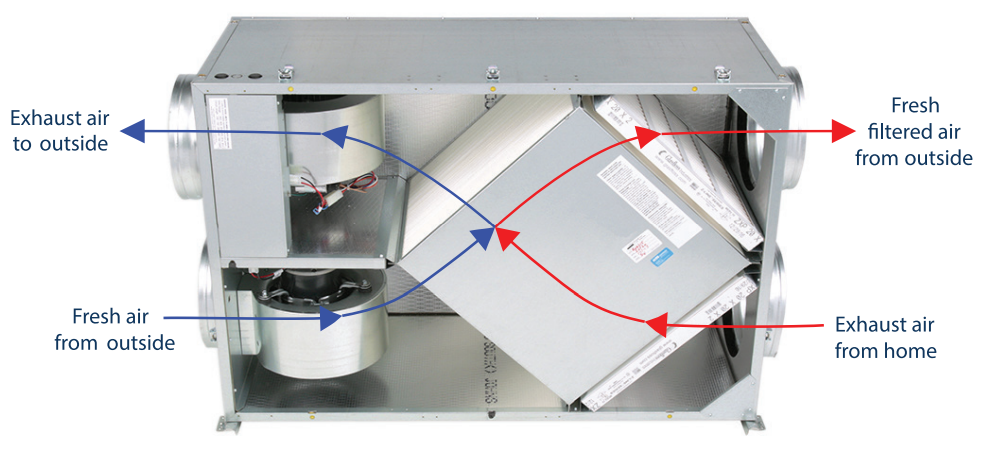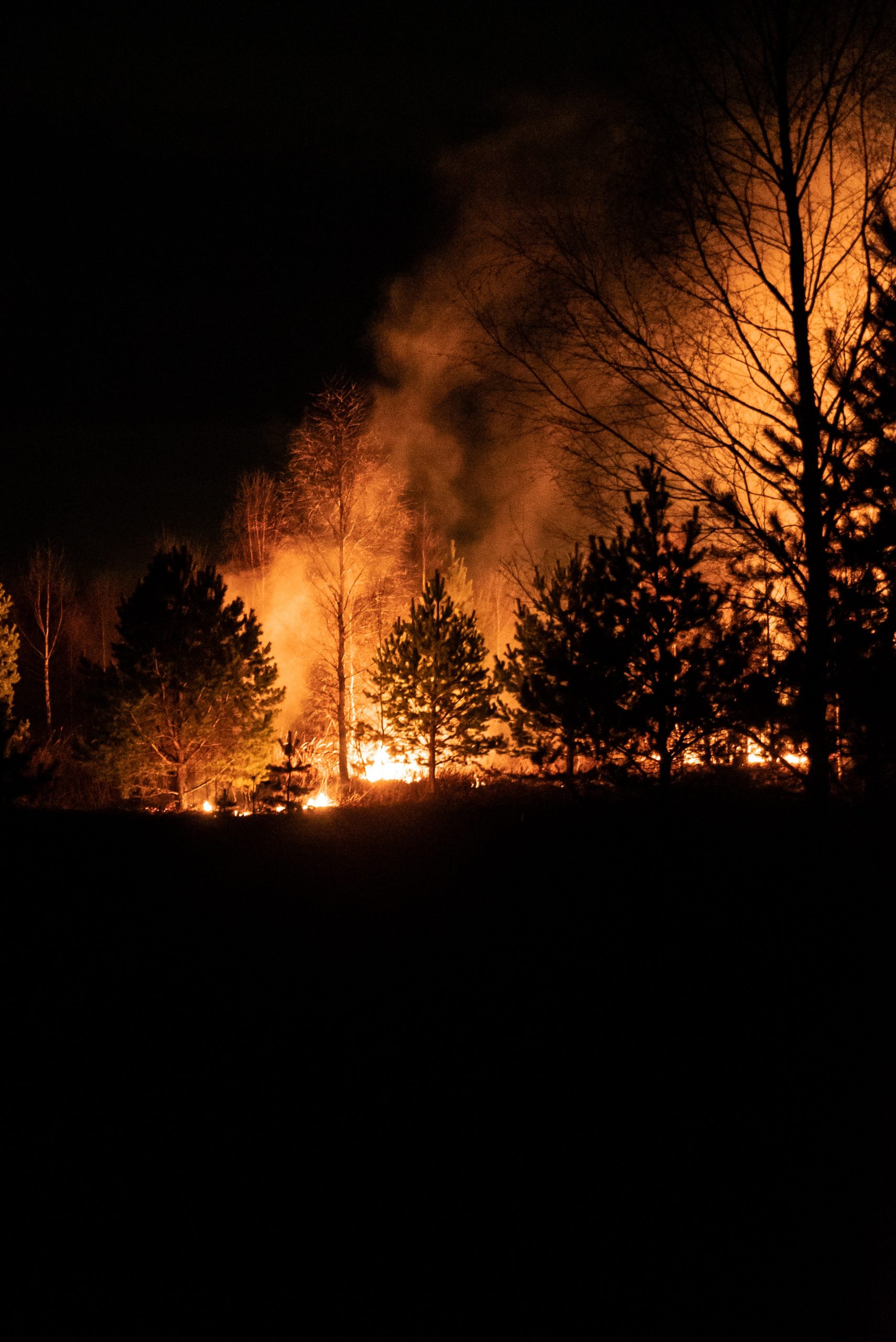Tight homes need ventilation, but what do I do when it’s smokey outside?
Tight homes need ventilation, but what do I do when it’s smokey outside?
If you’re blessed to be living in a “tight” home (one that doesn’t allow much unintentional air leakage), you should know that mechanical ventilation is really helpful, if not necessary, to achieve healthy indoor air. Humidity, CO2, particulates and VOCs can build up inside your tight home and without intentional ventilation, can lead to major mold and health problems quickly. In this case, many people opt for an ERV or HRV so that the energy savings on their tight home don’t go “out the window” (literally!) by exhausting indoor air and pulling in outdoor air without some kind of energy exchange. For more basic information on building tightness, ERVs and HRVs, check out our article here.
If you have an HRV or ERV and live in an area prone to wildfires, you should prepare for them by having the proper filters in place and knowing what to do with your system. We’ve helped several clients prepare for this scenario recently, and the “smoke” was not all from wildfires! Sometimes neighbors with bad or even innocent habits like smoking, barbequing, or sittin’-round-the-campfire can all wreak havoc on your air quality.
First of all, be familiar with your HRV/ERV unit! This means knowing where it is, how to change its filters, and how to operate the different modes. Hopefully the installer did a good job of allowing room for maintenance, because just like a furnace/air handler, the filters must be changed or cleaned regularly in order for the unit to work well for many years.
Many units only come with standard MERV 8 filters, but these are not adequate to handle smoke. Smoke presents 2 problems: particulate matter (PM10 and PM2.5) and volatile organic compounds (VOCs). According to the US EPA, a HRV or ERV unit filter must have a Minimum Efficiency Reporting Value (MERV) of 13 to provide effective protection against particulate matter in the air we're going to breathe inside a home or office building if it's smokey outside. (How to keep wildfire smoke out of homes with mechanical ventilation systems?) Therefore, you’ll need to know what grade filters are in your unit now, and if they are below MERV 13, inquire with the manufacturer on which filters to upgrade to.
Before you buy new filters, however, you should consider the other part of smoke: VOCs. You can have a MERV 16 in your unit, but it will not capture VOCs and your home will be filled with the smell of smoke if there is smoke outside! These insidious gasses are most easily removed with activated carbon. Therefore, a layered filter (with MERV13 or more plus activated carbon) is really the best defense against smoke. Since not all units/manufacturers offer carbon in their filters, here are some other options to get rid of the particulates AND VOCs:
- Check our offerings to see if we have your filter size in a MERV 13 filter plus carbon.
- If not, you can cut and layer activated carbon media behind/under your manufacturer’s MERV 13 filter.
- ((Some units use “panel” filters which are basically squares of bulk filter cut to fit the unit. In this case you can cut your own using laminated MERV 13 and carbon media. ))
The following options are adapted from HRV with Smoke Filtration:
- Ensure there is positive pressure inside the house during wildfire events (some ERVs like Panasonic ERV can be balanced to deliver more air than is exhausted from home) so that smoke never wants to come in “illegally”.
- Add an inline fan/filter to the intake of the ERV. This would generate additional positive pressure without overloading the ERV fan and also filter the air before it hits the ERV. This one has a MERV 13.
- Get a local HVAC shop to fabricate a filter box that uses a regular furnace filter with MERV 13 (or higher) and carbon, sized sufficiently to overcome any static pressure concerns, and install it in the fresh air intake before the HRV, OR you can add a media filter cabinet to the fresh air intake of your HRV/ERV and leave out the HRV/ERV filter on that side. We can help with calculations on sizing the cabinet if you have the model of HRV/ERV available (basically it comes down to airflow/CFM).
- Lastly, you could add one or more air purifiers or Corsi-Rosenthal cubes (CR cubes) with HEPA/carbon) to your home. However, this is not ideal because the pollutants have already entered your home and you’re relying on these purifiers to clean your air, instead of having a “guard” filter at the entrance.
Now, here’s the part which requires discernment: in which mode to use the HRV/ERV.
According to this article on how to keep wildfire smoke out of your home, the intake dampers of HVAC systems should be closed during wildfire incidents, and the equipment should be configured to only recirculate indoor air. Before any smoke event occurs, you should check that the intake dampers have seals on them and they actually close tightly. In case you think that you would run out of oxygen in a very short time in this scenario, that just isn’t the case. Consider this calculation for 1 person staying in a completely sealed space of approximately 600 ft2; they would possibly die of carbon dioxide poisoning (at 12 days!) before low oxygen would be an issue. Here’s where having carbon in your filters is also good, because it can also filter out some CO2 from inside your home while you close the outside vent and recirculate. We think that a CO2 meter is a great thing to keep on hand whether or not your home is tightly sealed, and especially if you have any combustion appliances (like gas stoves, water heaters, furnaces, dryers, etc.)
(I wouldn’t even worry about this “12 days” deadline, either, because very-tightly sealed homes are very rare! A home in Alaska currently holds the record for being the world’s tightest home, and the owner/builder took the ingenious route of building a “box within a box” in order to air-seal and insulate it well enough for the climate. At 600 ft2, it has a rating of 0.05 air changes per hour at 50 pascals of pressure (ACH50). This is less than 10% of the very rigorous Passivhaus standard, which is 0.60 ACH50.)
So, recirculating air instead of bringing in outside smokey air has a few benefits:
- It saves your filters and uses them only to filter the small amount of smoke that leaks in through unauthorized leaks (or briefly opening a door).
- It maintains the air quality of the room above that which you would have if you were bringing in outside smokey air.
- Depending on where the intake filter is located, it could save you cleaning your HRV by not passing unfiltered smokey air through it.
This last point may not be obvious, but not all HRV/ERV manufacturers consider that wildfire smoke is a real threat to the operation of their units, because some have intake filters on the exhaust side of the heat exchanger:
Source: “How ERVs Work”
Do you see the “Fresh air from outside” on the lower left? Imagine that this is “smoky air from outside”, passing through the fan and then through the heat exchanger, before passing through the filter on the upper right. All those particulates just passed through a heat exchanger, and it’s likely that some of them get stuck there until they are manually cleaned out. Particles sticking to a heat exchanger reduce its efficiency and depending on their chemical makeup, may damage the surface of the heat exchanger. Now, placing the filter on the lower left poses a maintenance issue, but it shouldn’t negatively affect the operation of the fan or heat exchanger. This is why having a separate filter on the fresh air intake before the HRV/ERV and leaving off that top right filter inside the unit, may be the best option in wildfire areas.
One last point: although we’re not huge fans of completely “smart” homes due to the EMF they emit, if you travel a lot or have an HRV/ERV system installed in a vacation home, it is worth practicing operating it remotely (via an app). In real emergencies, roads can be closed quickly and if you are not able to get home right away, it becomes the difference between being able to come “home” to a clean house and one that smell like smoke (because even carbon filters will not be able to adsorb VOCs for an extended or intense event).
Any smoke (cigarette, wildfire, campfire, barbeque, industrial or traffic accidents, etc.) is very unhealthy, so we need to do our best to keep it out of our homes, even at the cost of not ventilating for the duration of the smoke event. The particulate matter in smoke is especially dangerous for children and people with respiratory or cardiac conditions, because fine particulates can pass from the lungs to the bloodstream. The best line of defense against particulate matter is an airtight building envelope, which by extension means closing the intake dampers of ventilation systems. Filters with a MERV 13 rating or higher, and activated carbon if possible, should be used in HRV or ERV systems and central air conditioning units so that these units can remove any smoke that gets in. One or more portable air cleaners with a HEPA filter and carbon are also a very good addition for use in common rooms or bedrooms at night. It all comes down to preparation…having the filters on hand (or better yet, already installed) and knowing how your unit works is worth a lot of clean air when the smoke suddenly appears around your home!
Photo by Egor Vikhrev on Unsplash



